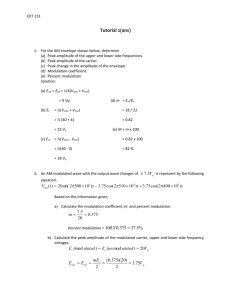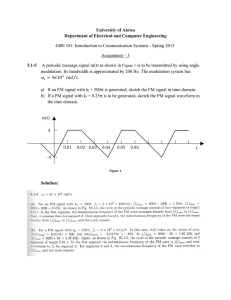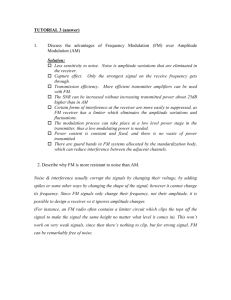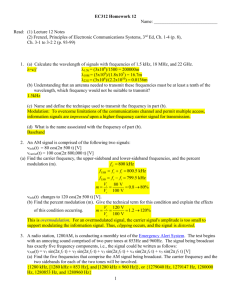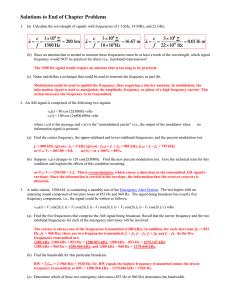eet368 homework #3 key
advertisement
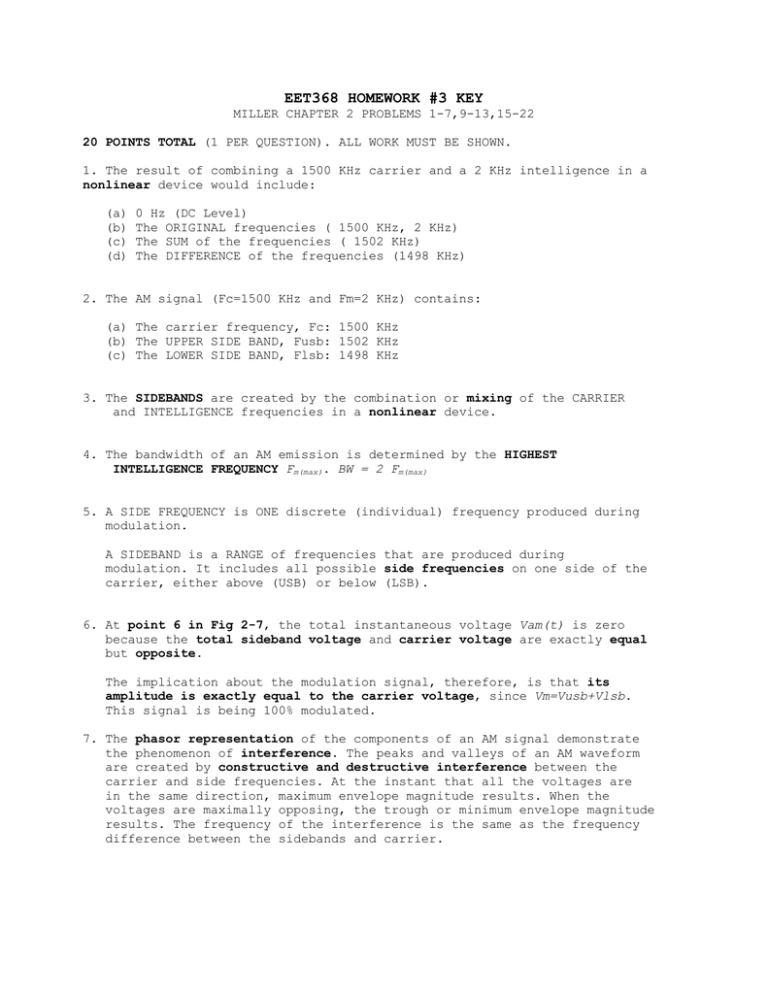
EET368 HOMEWORK #3 KEY
MILLER CHAPTER 2 PROBLEMS 1-7,9-13,15-22
20 POINTS TOTAL (1 PER QUESTION). ALL WORK MUST BE SHOWN.
1. The result of combining a 1500 KHz carrier and a 2 KHz intelligence in a
nonlinear device would include:
(a)
(b)
(c)
(d)
0 Hz (DC Level)
The ORIGINAL frequencies ( 1500 KHz, 2 KHz)
The SUM of the frequencies ( 1502 KHz)
The DIFFERENCE of the frequencies (1498 KHz)
2. The AM signal (Fc=1500 KHz and Fm=2 KHz) contains:
(a) The carrier frequency, Fc: 1500 KHz
(b) The UPPER SIDE BAND, Fusb: 1502 KHz
(c) The LOWER SIDE BAND, Flsb: 1498 KHz
3. The SIDEBANDS are created by the combination or mixing of the CARRIER
and INTELLIGENCE frequencies in a nonlinear device.
4. The bandwidth of an AM emission is determined by the HIGHEST
INTELLIGENCE FREQUENCY Fm(max). BW = 2 Fm(max)
5. A SIDE FREQUENCY is ONE discrete (individual) frequency produced during
modulation.
A SIDEBAND is a RANGE of frequencies that are produced during
modulation. It includes all possible side frequencies on one side of the
carrier, either above (USB) or below (LSB).
6. At point 6 in Fig 2-7, the total instantaneous voltage Vam(t) is zero
because the total sideband voltage and carrier voltage are exactly equal
but opposite.
The implication about the modulation signal, therefore, is that its
amplitude is exactly equal to the carrier voltage, since Vm=Vusb+Vlsb.
This signal is being 100% modulated.
7. The phasor representation of the components of an AM signal demonstrate
the phenomenon of interference. The peaks and valleys of an AM waveform
are created by constructive and destructive interference between the
carrier and side frequencies. At the instant that all the voltages are
in the same direction, maximum envelope magnitude results. When the
voltages are maximally opposing, the trough or minimum envelope magnitude
results. The frequency of the interference is the same as the frequency
difference between the sidebands and carrier.
9. Draw a diagram of a carrier wave envelope when modulated 50% by a sinusoidal
wave. Indicate on the diagram the dimensions from which the percentage of
modulation is determined.
THE DIMENSIONS "Vmax" AND "Vmin" SHOULD BE SHOWN ON THE
WAVEFORM IN ORDER TO DETERMINE THE PERCENTAGE OF
MODULATION.
THE EXAMPLE ABOVE SHOWS 50% MODULATION, WHICH MEANS
THAT Vmax = 3*Vmin.
10. Some possible consequences of OVERMODULATION are:
•
•
Distorted sound at the receiver.
Excessive bandwidth (SPLATTERING).
11. If the UNMODULATED carrier is 300 V p-p, then the %m can be calculated
for each "maximum p-p value" as follows:
By symmetry, we know that Vmax is the same amount larger than Vunmod
That Vmin is smaller than Vunmod.
For example, Vunmod is 300 Vpp. Vmax is given as 400 Vpp, so they are
100 Vpp different and Vmin is therefore going to be 300 Vpp – 100 Vpp
(the difference) = 200 Vpp. Therefore:
a) m =
V max − V min 400Vpp − 200Vpp
=
= 0.333 = 33.3%
V max + V min 400Vpp + 200Vpp
b) m =
V max − V min 500Vpp − 100Vpp
=
= 0.666 = 66.6%
V max + V min 400Vpp + 100Vpp
c) m =
V max − V min 600Vpp − 0Vpp
=
= 1 = 100%
V max + V min 600Vpp + 0Vpp
12. In figure 2-8, A=200V and B=60V. A is really Vmax and B is Vmin, so we get:
m=
V max − V min 200Vpp − 60Vpp
=
= 0.5385 = 53.85%
V max + V min 200Vpp + 60Vpp
13. Ec is the average of Vmax and Vmin:
Ec = (Vmax+Vmin)/2 = (100 Vpk + 30 Vpk) / 2 = 65 Vpk (45.96 Vrms)
Em is the difference between Vmax and Ec (or Ec and Vmin):
Em = Vmax – Ec = 100 Vpk – 65 Vpk = 35 Vpk (24.75 Vrms)
15. Given Vc=100 V, Fm=1 KHz, m=0.75 (75%) modulation, determine the sidefrequency amplitudes.
Since m = Vm/Vc, we know that Vm=m Vc = 0.75 (100V) = 75 V.
Each sideband gets 50% of the information voltage, so:
Vusb = Vlsb = Vm / 2 = 75V/2 = 37.5V
16. Given Fc=1 MHz, Vc=40 V pk, Fm=5 KHz, m=0.7, RL = 50 Ohms;
Calculate the power of each spectral component in the antenna.
(a) Pc = Vc2 / RL = 40V
(b) Pusb = Plsb =
2
2
/ 50Ω = 16Watts
1 m2
2
= (1 / 2)(16W )(0.7 / 2) = 1.96Watts
Pc
2 2
m2
gives total sideband power.
Note: The term Pc
2
17. Find the carrier and sideband power if Pt = 500 W with the data from
problem 15. (m=0.75)
Pt = Pc(1 + m2 / 2) , so Pc = Pt / (1 + m2 / 2) = 500W/(1+0.752 / 2)
Pc = 390.24 Watts
Psidebands = Pt - Pc = 500W - 390.2439W = 109.76 Watts
18. Find %m when Iantenna = 6.2A (Unmod) and 6.7A (modulated).
The solution may be derived by writing the power equation in terms of
current: (Recall that P = I2 R)
Let Itu = Unmod current = 6.2 A
Itm = Mod current = 6.7 A
Pt = Pc(1 + m2/ 2) by definition.
Then substituting the currents, we get:
Itm2 RL = Itu2 RL ( 1 + m2 / 2)
, since P = I2 R
Solving for "m" yields:
m= 2
Itm 2
6.7 A 2
−
1
=
2
− 1 = 0.579295 = 57.93%
Itu 2
6. 2 A 2
19. It is important to have a high percentage of modulation because THE
POWER IN THE SIDEBANDS IS MAXIMUM AT 100% MODULATION, AND
SIDEBANDS CARRY THE INFORMATION.
20. At 100% modulation, the sidebands contain the following percentage
of the AVERAGE TOTAL power:
Under 100% modulation, the power of the carrier is Pc, a constant.
The power in the sidebands is given by the power equation:
Pt = Pc(1 + m2 / 2) =
Pc(m2 / 2)
Sideband Power
Pc(1)
+
Carrier Power +
Psb / Pt = Percentage = Pc(m2 / 2) / Pt
=
Pc(m2 / 2) / Pc(1 + m2 / 2)
= 1/3 = 33.3 %
21. Given 3 equal amplitude tones modulating a transmitter with
m(effective) = 0.8, and Pc = 1 KW, calculate:
(a) The individual values for m1, m2, m3.
meff = m12 + m 22 + m 32
When m1=m2=m3, we can let m equal any of the three indices
and write:
meff = 3m 2
Solving for ‘m’ yields:
m = m eff
1
1
= 0.8
= 0.462
3
3
(b) The total transmitted power Pt.
m2
0.8 2
Pt = Pc (1 +
) = 1000W (1 +
) = 1320Watts
2
2
22. A 50 V RMS carrier is modulated by a square wave whose amplitude is
20 V peak (40 V p-p). What is m(effective) considering only the
first 4 harmonics?
meff = m12 + m 22 + m 32 + m 42
Where m1..4 are the individual modulation indices caused by each
spectral component of the information signal.
A Fourier analysis of the square wave reveals that each harmonic
has an RMS voltage of:
Bn =
4A
nπ 2
(RMS Volts)
Where n = { 1,3,5,7 } for the first 4 terms of
the series, and A=20Vpk (given).
Therefore, m(n) = Bn / Vc, and each spectral component is
computed:
n
Bn(RMS)
m(n)
-----------------------1
18.00
0.360
3
6.00
0.120
5
3.60
0.072
7
2.57
0.0514
(Fundamental/1st Harmonic)
(3rd Harmonic)
meff = 0.36 2 + 0.12 2 + 0.072 2 + 0.0514 2 = 0.389 = 38.9%

